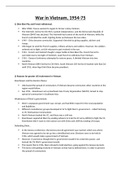War in Vietnam, 1954-75
1) Dien Bien Phu and French withdrawal.
After WW2, France wanted to regain its former colony Vietnam.
The Vietminh, led by Ho Chi Minh, wanted independence, and the Democratic Republic of
Vietnam (DMV) was declared. The Vietminh had control of the north of Vietnam, while the
French controlled the south. Fighting broke out between the two sides.
1949 – China became communist. Supported Vietminh by giving supplies, advisers and
troops.
USA began to send the French supplies, military advisers and soldiers. However, the soldiers
ordered not to fight, as USA reluctant to get involved in the war.
1954 – French and Vietminh fought a major battle at Dien Bien Phu. French forced to
surrender due to strength of Vietminh. Lead French to withdraw from Vietnam.
1954 – Geneva Conference attempted to restore peace. It divided Vietnam into two
countries.
North Vietnam (DRV) led by Ho Chi Minh. South Vietnam (SV) led by US-backed ruler Bao Dai
until 1955, when Ngo Dinh Diem became president.
2) Reasons for greater US involvement in Vietnam.
Eisenhower and the domino theory:
USA feared the spread of communism. If Vietnam became communist, other countries in the
region would follow.
Sep 1954 – Eisenhower set up Southeast Asia Treaty Organisation (SEATO). Aimed to stop
spread of communism in Southeast Asia.
Weaknesses of Diem’s government:
Diem’s unpopular government was corrupt, and had little respect for the rural population
and Buddhists.
Different revolutionary groups developed in SV to fight Diem’s government – called Vietcong
or VC (Vietnamese Communists).
North Vietnam backed the VC, and there was a civil war.
Eisenhower supported Diem by sending advisers to train the SV army (ARVN) to fight the VC.
Eisenhower didn’t want to risk nuclear war with China and USSR by sending US troops.
Defending Diem…
In the Geneva conference, the Geneva Accord agreement was reached, which was where
Vietnam was agreed to be set up into a demilitarised zone. Elections were to be held in
1956, which would make a government of Vietnam.
However, it seemed as though Diem’s government wouldn’t be voted into power, and
instead Ho Chi Minh’s government would.
This meant that in 1956, Diem refused to hold elections, going against the Geneva Accords.
This led to USA getting involved in Vietnam as they had to defend Diem, in order to prevent
the spread of communism.
, 3) Kennedy’s tactics against Vietnam.
Kennedy became US President in 1961.
Wanted to avoid direct military action in Vietnam.
Recognised VC were gaining ground.
Sent more advisers to SV.
Authorised use of chemical sprays, like Agent Orange, to kill crops and jungle areas the VC
were hiding in.
1961 – Kennedy requested a report on the feasibility of sending US soldiers for active service
in Vietnam.
4) US concerns leading to Diem’s overthrow.
Jan 1963 – ARVN lost Battle of Ap Bac, even though it had US air support and five times as
many soldiers as the VC.
US media reported the battle as a defeat, despite government attempts to present it
positively. JFK worried about the negative publicity of Diem’s leadership.
May 1963 – Diem’s government troops fired on a Buddhist procession, killing nine, adding to
Diem’s unpopularity among the Vietnamese people.
June 1963 – Buddhist monk burned himself to death in protest about Diem’s government.
His protest generated worldwide publicity.
JFK put pressure on Diem to make peace with Buddhists, but Diem continued his
persecution.
JFK made it obvious he withdrew all support for Diem’s leadership.
Nov 1963 – ARVN generals overthrew and assassinated Diem.
5) Strategic Hamlet Program
1962.
Diem and USA built new villages to house locals away from the VC, so the VC couldn’t recruit
them to fight.
Aim was to provide security for the villagers and create support for the government.
ARVN forcibly remove and relocated villagers. However, the villagers didn’t want to leave
their ancestral homes. Also, there wasn’t enough food or basic provisions in some of the
new villages, so many started to die. Made Diem and USA more unpopular in SV.





